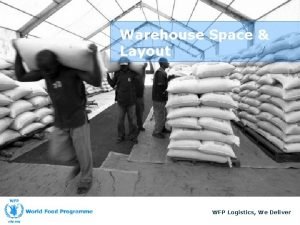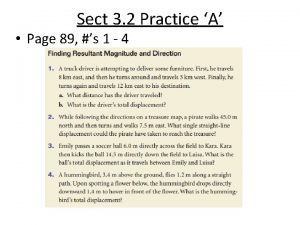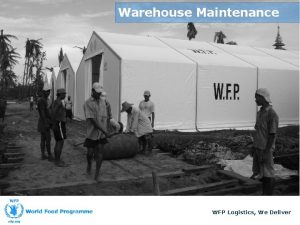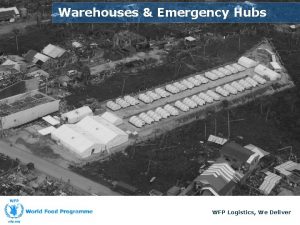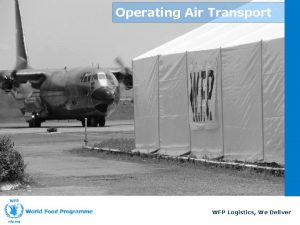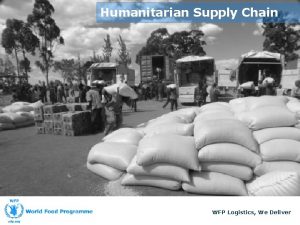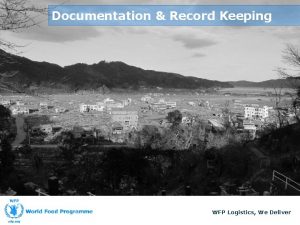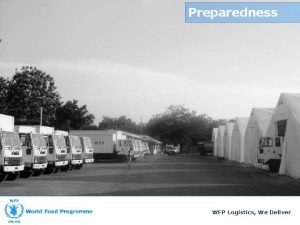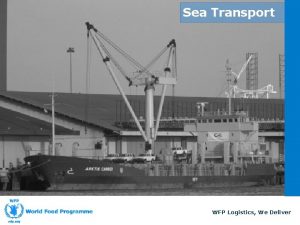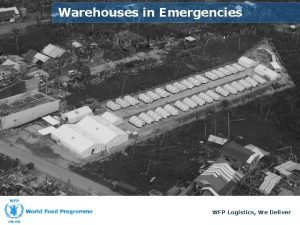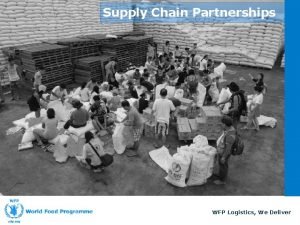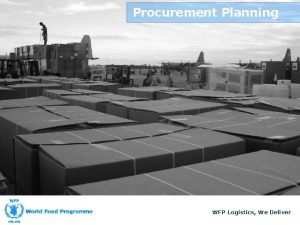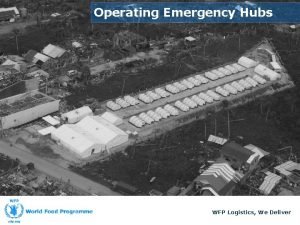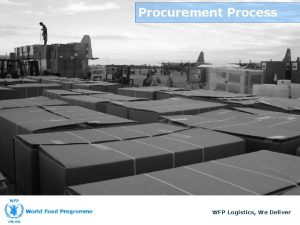Warehouse Space Layout WFP Logistics We Deliver Lesson
























- Slides: 24

Warehouse Space & Layout WFP Logistics, We Deliver

Lesson Objectives By the end of this lesson, you will be able to: 1 Describe the different stacking methods 2 Use the stowage factors and calculate the stacking capacity in a warehouse

Warehouse Functions Three Aspects to Consider Structural Elements Organizational Elements Managerial Elements

Different Areas in the Warehouse Work Area Goods receipt Storage Picking/ Kitting Repacking/ Recondition Goods Dispatch

Stacking Methods

Stacking Methods

Stacking Methods Clean area before creating stack Use good and clean pallets Select stacking method Identify space for spoiled and empty packaging Identify space for reconditioning & repackaging damaged cargo Use stack card

Stacking Methods Unbonded Stacking Bonded Stacking

Stacking Methods

Stacking Methods

Bad Practices Do not throw or drop The stack should be built to give a firm bonded or interlocked stack Do not stack so high that packages at the bottom are crushed or split X Do not stack too close to the roof reducing ventilation and access Do not stack close up to, or on top of, the roof beams so as to risk damaging the structure Remove projecting nails and splinters or the bottom bags may be torn and food spilt

Measurements – Commodities and Warehouse KG Weight (1000 KG) MT Area SQM (M 2) Length X Width Volume CBM (M 3) Length X Width X Height

Calculating Maximum Stack Capacity Stack Characteristics: Height; Width; Length; Weight Stowage Factor = Volume / Weight

Stowage factor You have received a commodity in boxes with the following characteristics: Height Width Length Weight 15 cm 45 cm 60 cm 0. 025 mtn What is the stowage factor of this commodity?

Stacking Exercise A. Calculate the stack capacity for the following: 1. 2. 3. Rice in 50 kg bags with a stowage factor of 1. 5 cbm/MT You have 70 pallets (size 1 m x 1. 2 m) Maximum storage height: 3 m B. What is the minimal number of pallets (1 m x 1. 2 m) required to store 200 MT of a commodity that has a stowage factor of 2? 1. 2. 3. Maximum storage height: 2. 5 m How many pallets will you need to square off the surface of the pallets? What are the surface dimensions of the stack?

Stacking Exercise Answer (A) A. Calculate the stack capacity for the following: 1. 2. 3. Rice in 50 kg bags with a stowage factor of 1. 5 cbm/MT You have 70 pallets (size 1 m x 1. 2 m) Maximum storage height: 3 m Usable Surface Area = 70 x (1 x 1. 2) = 84 sqm Usable Volume = 84 x 3 = 252 cbm Stack capacity = 252 /1. 5 = 168 MT

Stacking Exercise Answer (B) B. What is the minimal number of pallets (1 m x 1. 2 m) required to store 200 MT of a commodity that has a stowage factor of 2? 1. Maximum storage height: 2. 5 m 2. How many pallets will you need to square off the surface of the pallets? Step 1: Required volume (stack capacity) x (stowage factor) = (required volume) = 200 x 2 = 400 cbm Step 2: Required surface (required volume) / (max storage height) = (required surface) = 400 / 2. 5 = 160 sqm Step 3: Minimum number of pallets (required surface) / (surface of pallet) = (minimum number of pallets) = 160 / 1. 2 = 133. 3 Step 4: Rounded quantity of pallets needed Pallet dimensions = 1 x 1. 2 We plan for 8 pallets (1 meter side) wide floor The number of pallets per “column” is therefore = 133. 3 / 8 = 16. 6 = 17 pallets Number of pallets needed = 17 x 8 = 136 pallets

Stacking Exercise Answer (B) B. What is the minimal number of pallets (1 m x 1. 2 m) required to store 200 MT of a commodity that has a stowage factor of 2? 3. ( What are the surface dimensions of the stack? Surface dimensions of a stack: 136 x 1. 2 = 163. 3 sqm

Stowage factors: References

Stock Location: Racked

Warehouse Capacity Considerations Factors that affect warehouse storage capacity: Type, characteristics and compatibility of cargo Different storage requirements Warehouse size and structure Equipment Remember Available space = actual space + dispatches - receipts

Warehouse Layout Through-FLOW STORAGE AREA Truck GOODS RECEIPT PICKING GOODS DESPATCH Truck U-FLOW STORAGE AREA Truck GOODS RECEIPT PICKING & DESPATCH

Lesson Recap Questions: 1 What are the different stacking methods? 2 What is a stowage factor and how to calculate the stacking capacity in a warehouse?

Questions WFP Logistics, We Deliver
 Wfp logistics
Wfp logistics Wfp logistics
Wfp logistics Cfm/hotline operator
Cfm/hotline operator Miguel aragon
Miguel aragon 4 ps of leadership
4 ps of leadership Wfp vendor registration
Wfp vendor registration Csb plus
Csb plus Oxid wms
Oxid wms Warehouse capacity calculation formula
Warehouse capacity calculation formula Sekai reynosa
Sekai reynosa Sekai reynosa
Sekai reynosa Sekai sa
Sekai sa Stack card in warehouse
Stack card in warehouse Need 3 hali
Need 3 hali A truck driver is attempting to deliver some furniture
A truck driver is attempting to deliver some furniture How to make a entertainment speech
How to make a entertainment speech Interest rate futures
Interest rate futures What is the destructive event or prank the virus delivers
What is the destructive event or prank the virus delivers Where does “snowflake girl” help to deliver presents?
Where does “snowflake girl” help to deliver presents? Create deliver and capture value
Create deliver and capture value Together we deliver
Together we deliver Discover define develop deliver
Discover define develop deliver Guest laundry docket
Guest laundry docket Program dream design
Program dream design Does ups deliver on saturdays
Does ups deliver on saturdays








